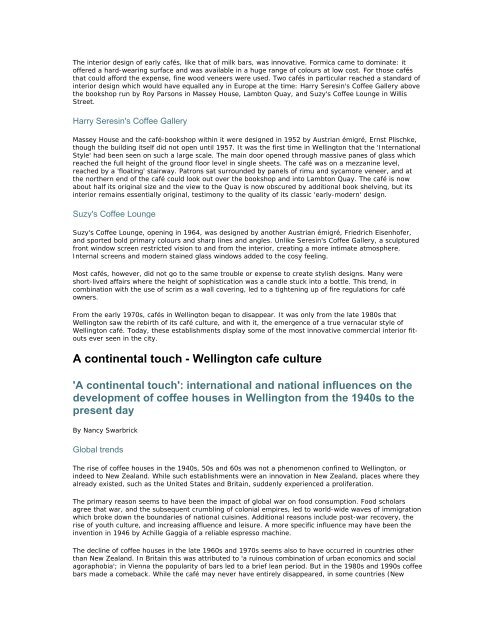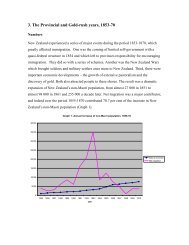Wellington cafe culture 1920-2000 - NZHistory.net.nz
Wellington cafe culture 1920-2000 - NZHistory.net.nz
Wellington cafe culture 1920-2000 - NZHistory.net.nz
You also want an ePaper? Increase the reach of your titles
YUMPU automatically turns print PDFs into web optimized ePapers that Google loves.
The interior design of early cafés, like that of milk bars, was innovative. Formica came to dominate: it<br />
offered a hard-wearing surface and was available in a huge range of colours at low cost. For those cafés<br />
that could afford the expense, fine wood veneers were used. Two cafés in particular reached a standard of<br />
interior design which would have equalled any in Europe at the time: Harry Seresin's Coffee Gallery above<br />
the bookshop run by Roy Parsons in Massey House, Lambton Quay, and Suzy's Coffee Lounge in Willis<br />
Street.<br />
Harry Seresin's Coffee Gallery<br />
Massey House and the café-bookshop within it were designed in 1952 by Austrian émigré, Ernst Plischke,<br />
though the building itself did not open until 1957. It was the first time in <strong>Wellington</strong> that the 'International<br />
Style' had been seen on such a large scale. The main door opened through massive panes of glass which<br />
reached the full height of the ground floor level in single sheets. The café was on a mezzanine level,<br />
reached by a 'floating' stairway. Patrons sat surrounded by panels of rimu and sycamore veneer, and at<br />
the northern end of the café could look out over the bookshop and into Lambton Quay. The café is now<br />
about half its original size and the view to the Quay is now obscured by additional book shelving, but its<br />
interior remains essentially original, testimony to the quality of its classic 'early-modern' design.<br />
Suzy's Coffee Lounge<br />
Suzy's Coffee Lounge, opening in 1964, was designed by another Austrian émigré, Friedrich Eisenhofer,<br />
and sported bold primary colours and sharp lines and angles. Unlike Seresin's Coffee Gallery, a sculptured<br />
front window screen restricted vision to and from the interior, creating a more intimate atmosphere.<br />
Internal screens and modern stained glass windows added to the cosy feeling.<br />
Most cafés, however, did not go to the same trouble or expense to create stylish designs. Many were<br />
short-lived affairs where the height of sophistication was a candle stuck into a bottle. This trend, in<br />
combination with the use of scrim as a wall covering, led to a tightening up of fire regulations for café<br />
owners.<br />
From the early 1970s, cafés in <strong>Wellington</strong> began to disappear. It was only from the late 1980s that<br />
<strong>Wellington</strong> saw the rebirth of its café <strong>culture</strong>, and with it, the emergence of a true vernacular style of<br />
<strong>Wellington</strong> café. Today, these establishments display some of the most innovative commercial interior fitouts<br />
ever seen in the city.<br />
A continental touch - <strong>Wellington</strong> <strong>cafe</strong> <strong>culture</strong><br />
'A continental touch': international and national influences on the<br />
development of coffee houses in <strong>Wellington</strong> from the 1940s to the<br />
present day<br />
By Nancy Swarbrick<br />
Global trends<br />
The rise of coffee houses in the 1940s, 50s and 60s was not a phenomenon confined to <strong>Wellington</strong>, or<br />
indeed to New Zealand. While such establishments were an innovation in New Zealand, places where they<br />
already existed, such as the United States and Britain, suddenly experienced a proliferation.<br />
The primary reason seems to have been the impact of global war on food consumption. Food scholars<br />
agree that war, and the subsequent crumbling of colonial empires, led to world-wide waves of immigration<br />
which broke down the boundaries of national cuisines. Additional reasons include post-war recovery, the<br />
rise of youth <strong>culture</strong>, and increasing affluence and leisure. A more specific influence may have been the<br />
invention in 1946 by Achille Gaggia of a reliable espresso machine.<br />
The decline of coffee houses in the late 1960s and 1970s seems also to have occurred in countries other<br />
than New Zealand. In Britain this was attributed to 'a ruinous combination of urban economics and social<br />
agoraphobia'; in Vienna the popularity of bars led to a brief lean period. But in the 1980s and 1990s coffee<br />
bars made a comeback. While the café may never have entirely disappeared, in some countries (New








